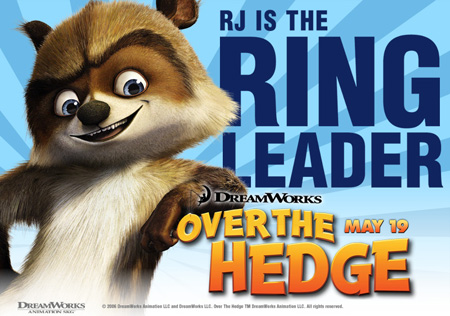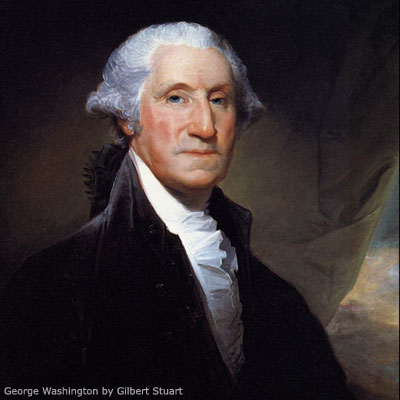Category ArchiveMovie TV DVD Review
Animation &Media &Movie TV DVD Review SpinMeister on 19 May 2006
Over The Hedge
Looks like something different from DreamWorks. Shrek was born from a strong counter-culture bent, and Over The Hedge appears to follow this spirit too.

American History &Movie TV DVD Review SpinMeister on 23 Mar 2006
Feingold’s Clarity

Here is video and coverage of Senator Russ Feingold‘s refreshingly clear stance on his proposal to censure President Bush.
Perhaps Americans’ vast knowledge of The Simpsons and American Idol trivia over their own Constitutional rights, has clouded our memory of Amendment 1 of the Bill of Rights which includes our right to “petition the government for a redress of grievances.”
So America needs a Simpsons show where Bart recites parts of the Constitution and Russ Feingold makes an appearance. Go man, go!
American History &Money &Movie TV DVD Review SpinMeister on 13 Mar 2006
Why We Fight II

When writing a previous review of John Ford’s classic World War II propaganda films, Why We Fight, I was not aware that another newer film Why We Fight was in the works. Well, this has been a season for remakes, why not documentaries too?
The earlier WWII Why We Fight was designed as a nudge to a neutral inward looking United States, whereas the new Why We Fight covers the now well established American military industrial complex. Might as well face it, never mind oil… these days we’re addicted to war.
Some may justify their jobs in the defense business sector; it’s good for the U.S. G.N.P., stock market, ya-da ya-da. As far as I can tell, the Iraq War has been nothing more than a three year economic stimulus package engineered by the Bush administration. Taken a look at a Halliburton stock chart since March 2003 lately? Back in Nixon’s day there was aversion to ending the Vietnam War, because it would hurt the job market with too many baby boomers coming home and competing for a piece of the great American Dream Pie. Chances are we won’t work our way out of this habit until it all blows up in our collective Old Glory faces.
Animation &Movie TV DVD Review SpinMeister on 09 Mar 2006
Scan Me Out

After the tedium of months of doing rotoscoping on Shrek 2, why on Earth would I imagine doing an even more extreme version of it in Austin, Texas on A Scanner Darkly? The thought did cross my mind. Doing a feature length rotoscoped movie requires a marathon runner’s mentality, and ideally a lot of weed.
I could have done it, but talked myself out of it. The idea of moving to Austin to work on a punishingly tedious test of patience seemed like a quest I could take a pass on. Good thing too. The current issue of WIRED magazine recounts in Trouble In Toontown the realities of coping with the super sluggish process of photo-realistically tracing every ding-dang frame of digital video.
The original Linklater groundbreaking, experimental rotoscoped film Waking Life was the beginning of something freaky, but with Scanner somehow being able to say, “Yeah we could do that,” came too easily. Perhaps as bad an idea as, “Let’s redo Fantasia! …again.” I’ve read a number of P. K. Dick’s books, and A Scanner Darkly was a bit too dark and introspective for me to care to finish. A creepy story about a paranoid narc becoming addicted while bumming around suburbia with his deadbeat house mates. The monk-like mind-numbing hours of rotoscoping in dark rooms is no far cry from the cold, dark world of P. K. Dick’s story.
Rotoscoping, the tracing of live footage to create animation, was done by Disney way back on Snow White and Cinderella, and then Ralph Bakshi did some awfully disappointing stuff in American Pop. Bob Sabiston and his crew at Flat Black Films deserve a lot of credit for Waking Life, but after A Scanner Darkly they should be ready to turn out the lights and wake up to a new life.
Media &Movie TV DVD Review &Politics SpinMeister on 03 Mar 2006
Video 116: Documentary Turns 911 Upside Down
Loose Change 2nd Edition is a hard hitting, provocative 9/11 documentary that can be viewed at Google Video. The observations in the documentary are highly disturbing, which many Americans would prefer not to believe: that the 9/11 was a staged event by our own government to create a Pearl Harbor II as a pretext for Middle Eastern wars, political power grabs, gold, insider stock profits and insurance money.
The documentary covers these 9/11 mysteries:
- a missile-like hole in the Pentagon and lack of aircraft debris.
- black box flight recorders not retrieved.
- lack of aircraft debris or bodies found at Pennsylvania “crash” site.
- explosion evidence at base of twin towers, far from aircraft initial impact.
- evidence of controlled demolition explosions at WTC buildings 1, 2 and 7.
- inability of cell phones on aircraft to contact phones on ground.
The stomach turning implications, if proven out, would of course be the horror story of the century. The documentary suggests that there are clues that could be tracked down, such as accused hijackers may still be alive, aircraft victims may still be alive, because planes were switched, and the list of deep, dark secrets goes on and on. Could so many innocent people be sacrificed for such a ruse? Could so many Americans be fooled? Who knows?
Online resources such as Killtown.org have collected theories and evidence.
Update:Â New York Magazine’s article, The Ground Zero Grassy Knoll.
Media &Movie TV DVD Review SpinMeister on 02 Mar 2006
Oscar Nominated Documentary Short: The Death of Kevin Carter
Today on the KQED radio program Forum, documentary filmmakers D.A. Pennebaker (“Don’t Look Back”), Richard Leacock, Stephen Ujlaki, director of the Documentary Film Institute at SF State University, and Dan Krauss, Bay Area filmmaker whose film “The Death of Kevin Carter” is nominated for an Academy Award discussed their craft. Part of their debate was if the documentary filmmaker should be a “fly on the wall” or not.
My own experience shooting photographs of rock bands performing in small clubs is that the performers know you are there and they know how to act. As a photographer I’ve felt the need to be “cold blooded” in order to best capture a moment. The focus is on the technical aspects of the film, lighting, camera and lens fitting the subject into the frame. A good photographer calmly and cooly stalks the great image and can only indulge in emotional reactions after it has been successfully captured. I know people who have flown to war zones in order to find “great” photographs, and that is not for me.
Dan Krauss discussed the dilemma of whether or not to become in involved in the subject matter, explored in his Oscar nominated documentary short about photographer Kevin Carter who won a Pulitzer Prize for his picture (above) of a Sudan famine victim above. Mr. Carter was haunted by the photo and committed suicide, tormented by his conscience and other critics for exploiting the suffering of others.
Humor &Internet &Movie TV DVD Review SpinMeister on 22 Feb 2006
Peepers in Bollywood
 So I’m goofing off, browsing Google Video and come across this silly Bollywood Comedy video… a cute idea, mouthing the words and aping to one of those syrupy Hindu pop songs. Then the comedian throws in an added feature, a strange little finger puppet. Hey, wait a second! That looks like something a friend, puppeteer Hobey Ford, showed me 4 or 5 years ago… a toy that he developed and patented, the Peepers Puppet. Small world, even if you’re not a puppet.
So I’m goofing off, browsing Google Video and come across this silly Bollywood Comedy video… a cute idea, mouthing the words and aping to one of those syrupy Hindu pop songs. Then the comedian throws in an added feature, a strange little finger puppet. Hey, wait a second! That looks like something a friend, puppeteer Hobey Ford, showed me 4 or 5 years ago… a toy that he developed and patented, the Peepers Puppet. Small world, even if you’re not a puppet.
Turns out, it’s a cheating world too. Hobey tells me the peepers in the video are knock-offs, with enlarged pupils… the tell-tale sign of drug using finger puppets from the underworld.
American History &Book Review &Movie TV DVD Review SpinMeister on 20 Feb 2006
Appreciating George Washington

Last month I caught glimpses of early American history in the two part PBS series The War That Made Americanarrated by Graham Greene, an Oneida Indian. The program shows young George Washington, a 22 year old Virginia militia officer leading men west into the uncivilized Ohio country. He is an powerful six foot two inch woodsman, who understands the value in learning wilderness survival skills of the native Americans and forms alliances with Indian leaders in order to defeat the French’s ambitions to possess their share of the new frontier. Washington faces many dangerous battles with the French, Indians and Nature itself west of the Blue Ridge Mountains between 1754 and 1759, accompanied with legendary characters such as Daniel Boone at the Massacre at Monongahela.
Exhilarated to learn more of the dashing young Mr. Washington, I found just the right book, His Excellency: George Washingtonby Joseph J. Ellis. Published in 2004, the author is a scholar of the many Washington biographies and collections of letters, and therefore crafts a character study of George Washington the boy, the young man, and on through his life. The author’s goal is to tell the story of how great leaders such as Benjamin Franklin, Alexander Hamilton, John Adams, Thomas Jefferson and James Madison each acknowledged Washington as their unquestioned superior.
In this book I learned George Washington’s father died when he was only eleven years old, and the old tale about “I cannot tell a lie, I chopped down the cherry tree,” is baloney. At 16 he was working at his fist job, on surveying expeditions in the Shenandoah Valley. Out in this country Washington kept a journal of the primitive conditions and sightings of Indians on scalping parties. The story continues to describe numerous encounters and battles where Washington is surrounded by dead and wounded, and miraculously comes out unharmed. By only age 23 his remarkable capacity to endure had marked him as a man of destiny.
“I may point out to the Public that heroic youth Col. Washington, who I cannot hope Providence has hitherto preserved in so signal a Manner for some important Service to his Country.” – Reverend Samuel Davies.
Prophetic, and yet who then could imagine the legacy of our founding father would be inherited by what we have now?





